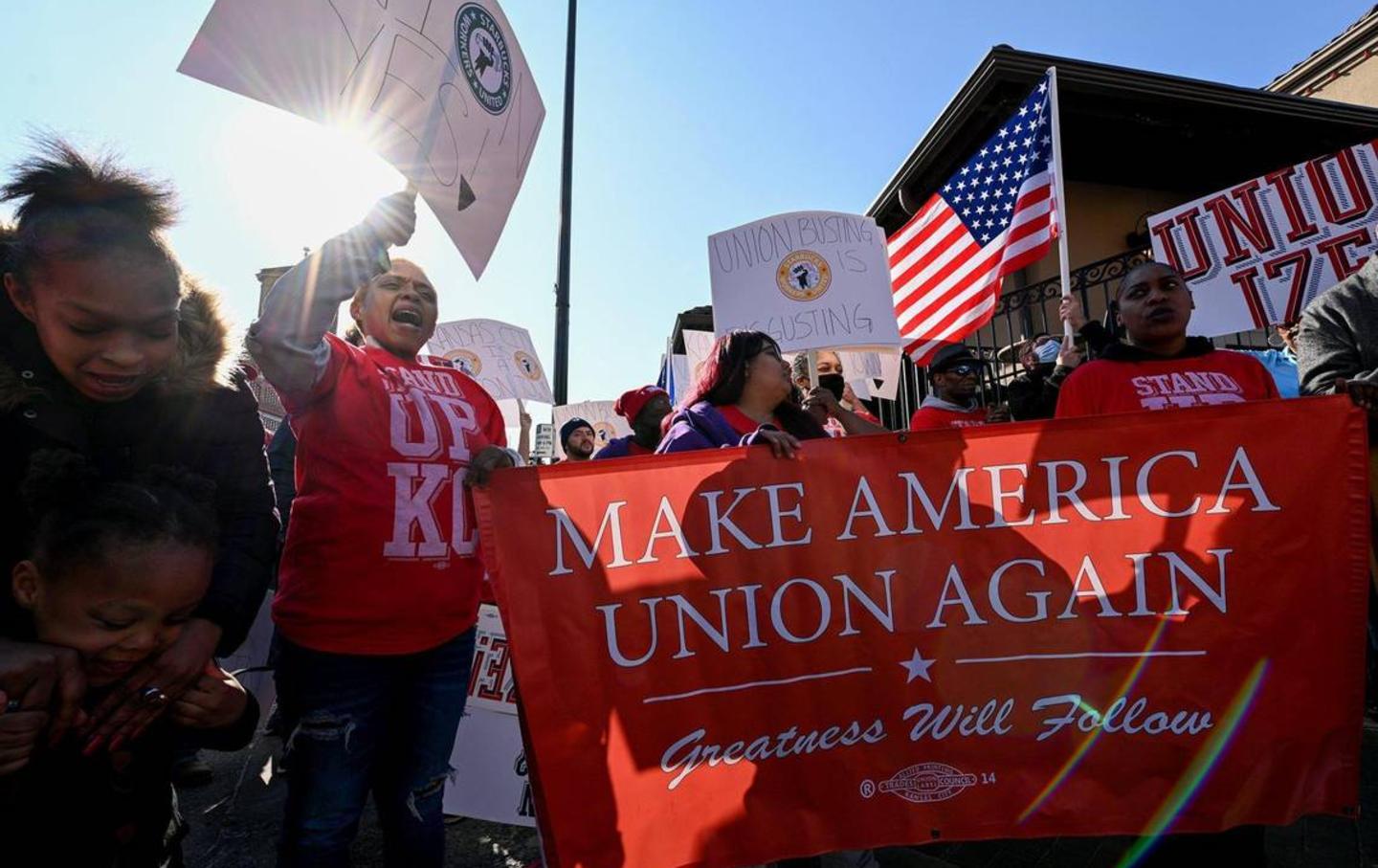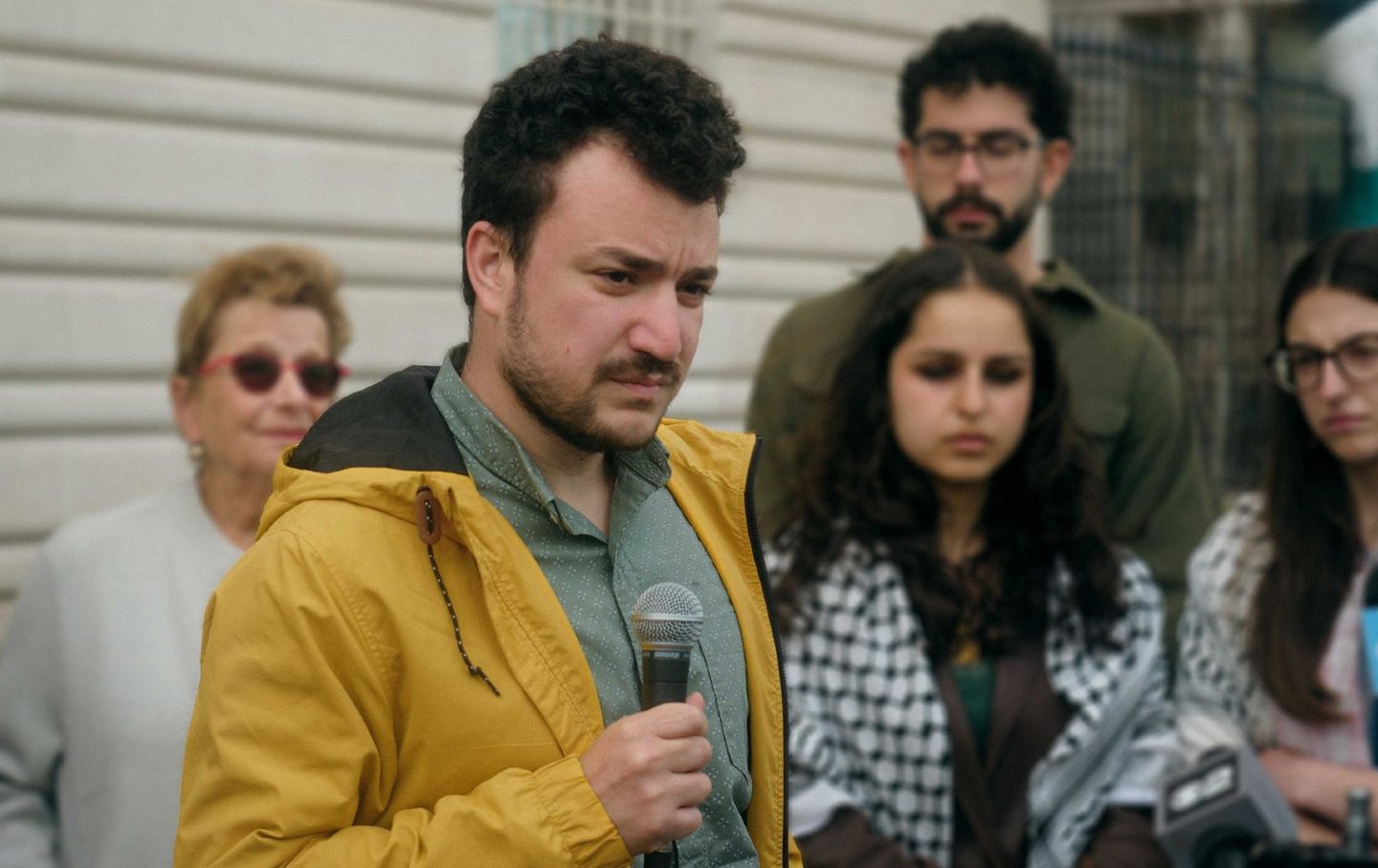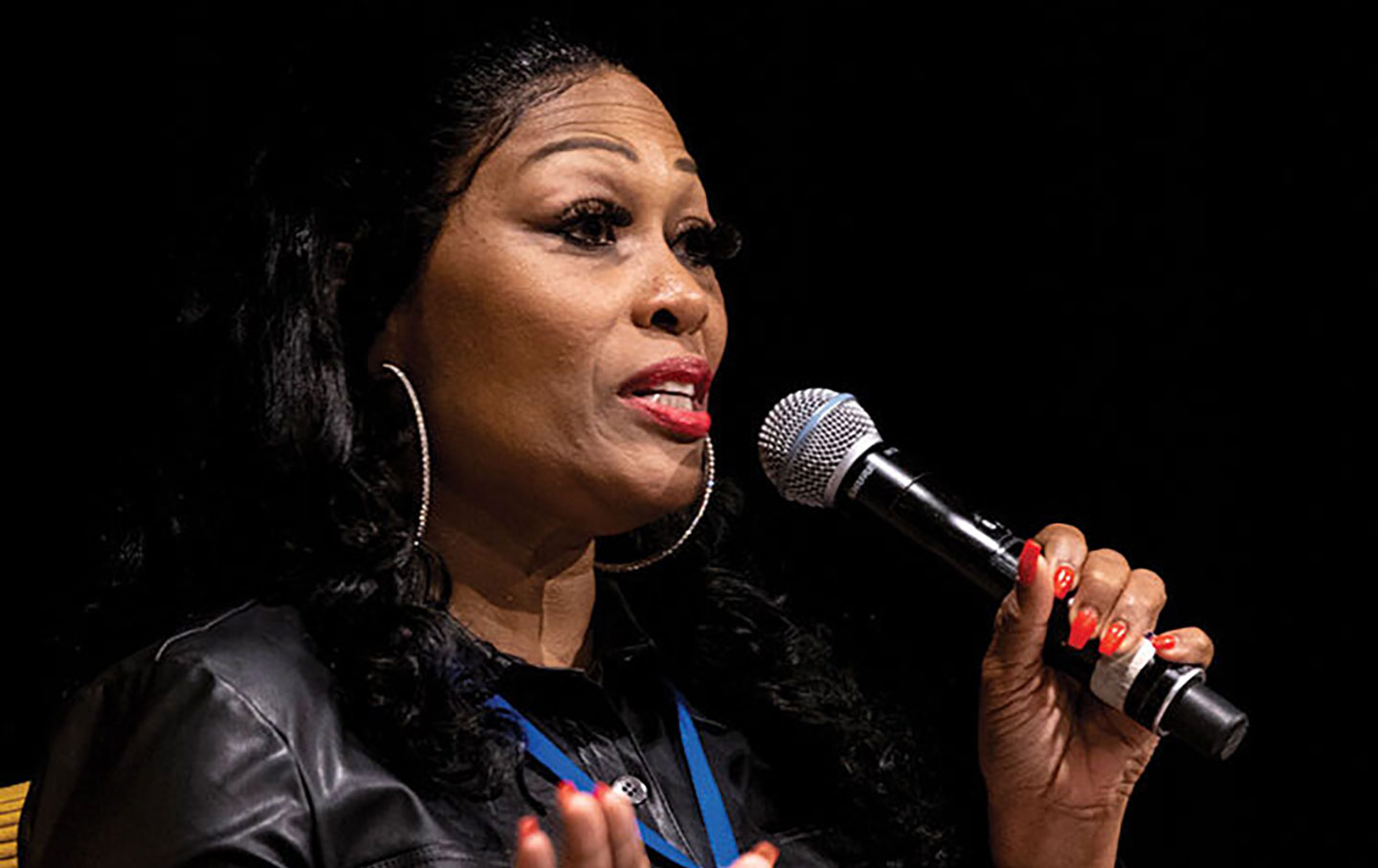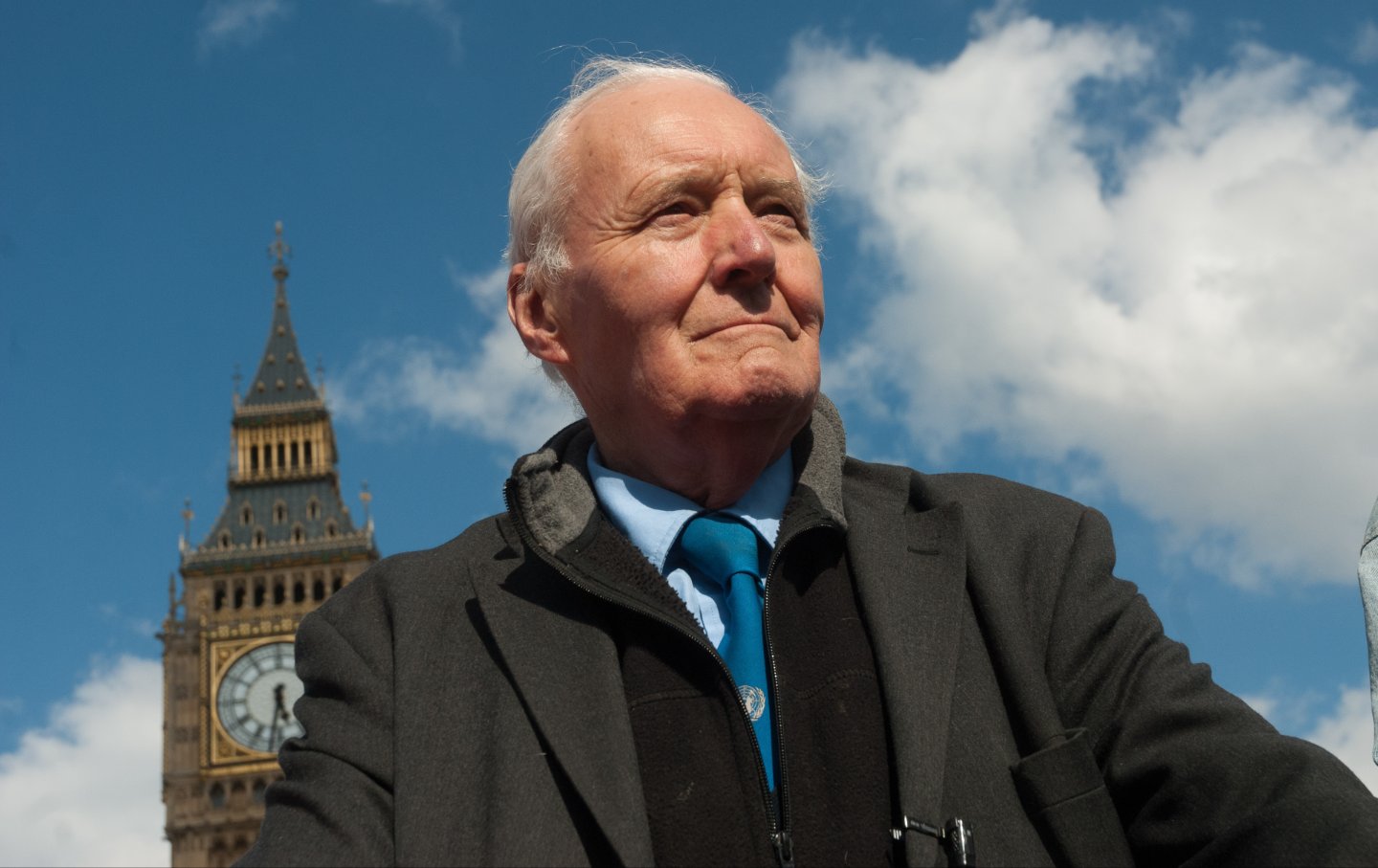The Call Is Out for Mass, Simultaneous Strikes in 4 Years
These labor leaders are organizing for 2028. Cooperation across unions and sectors—if carried out on a large scale—would be unprecedented in the 21st-century United States.
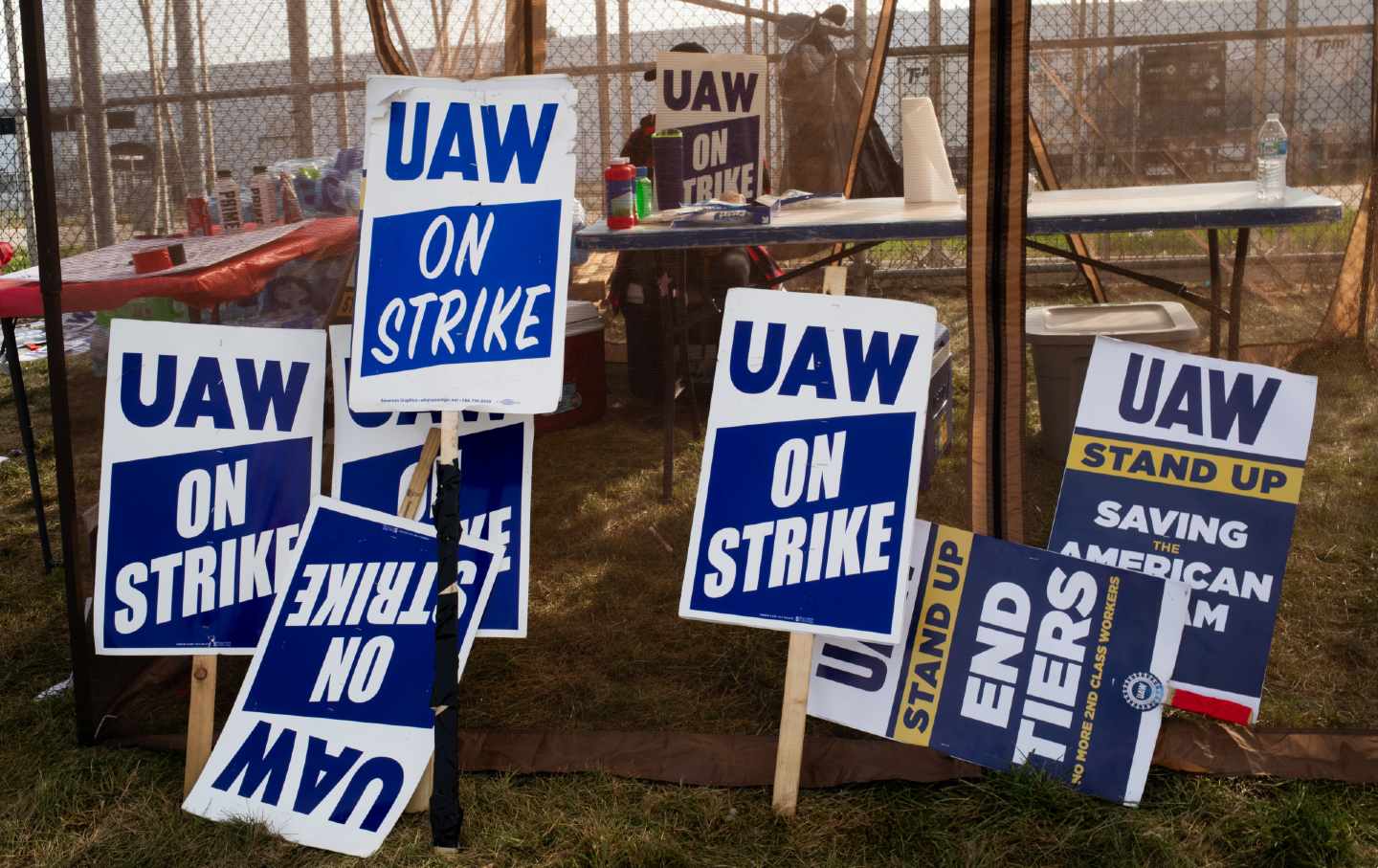
Signs wait ready for use as United Auto Workers (UAW) members and supporters picket outside the Stellantis NV Toledo Assembly Complex in Toldeo, Ohio, on September 22, 2023.
(Emily Elconin / Bloomberg via Getty Images)
There is a credible call for a general strike in the United States in four years.
The call first came from the United Auto Workers after its fall 2023 stand-up strike, in which the union took on the Big Three carmakers simultaneously in rolling, surprise work stoppages. All three contracts that emerged are slated to expire on the same day: May 1, 2028, International Workers’ Day. This is not the first time the UAW has aligned the Big Three contracts, but what the union did next is remarkable. It put out a challenge to the US labor movement: “We invite unions around the country to align your contract expirations with our own so that together we can begin to flex our collective muscles,” the UAW announced on October 29, 2023.
This appeal for joint expiration on such a meaningful day for workers opens up possibilities ranging from mass, simultaneous strikes that disrupt industries across the country to a tremendous number of concurrent contract campaigns that increase worker leverage. This kind of cooperation across unions and sectors—if carried out on a large scale—would be unprecedented in the 21st-century United States.
In the contemporary US context, most strikes occur when a contract has expired, in part due to the prevalence of no-strike clauses in collective bargaining agreements. (Though workers certainly strike at other times as well, for example, when fighting for first contracts or in political protest. And sometimes they strike in defiance of laws that prohibit certain workers from striking at all, as we saw during the wave of red-state teacher strikes.) It was contract alignment that enabled the UAW to strike all Big Three at once, and Shawn Fain, the UAW president, is urging the labor movement to scale up this kind of joint action. “We want a general strike,” Fain told the UAW’s national political conference in January 2024. “We want everybody walking out just like they do in other countries.”
The UAW’s public call set off waves throughout the US labor movement, which has not seen a general strike in 78 years, though they used to be more common in the early 20th century. Of course, urging coordination on this scale is one thing, and doing the organizing required to make it a reality is another. These days, calls for a general strike are often the domain of “starry-eyed dreamers,” Dan DiMaggio noted in a November 2023 article for Labor Notes.
But what makes the push stand out is who is making it. “Now the call is coming from a major international union” that has already aligned its own Big Three contracts representing 146,000 workers, DiMaggio wrote. Fain, for his part, is sober about the fact that “a general strike isn’t going to happen on a whim. It’s not going to happen over social media. A successful general strike is going to take time, mass coordination, and a whole lot of work by the labor movement.”
There are signs that credible unions and labor leaders are taking this coordination and work seriously. The Chicago Teachers Union AFT-IFT Local 1 is working with the UAW and other worker and training organizations to create an organizing institute for the express purpose of getting ready for May Day 2028. Some major unions, like the American Federation of Teachers, are formally supporting the effort to align contracts, alongside a growing number of local, regional, and labor bodies within the AFL-CIO. Labor activists say interest and momentum are spreading, including among rank-and-file formations like Unite All Workers for Democracy, a grassroots movement within the UAW.
Details are yet to be worked out; it is not clear, for example, whether there will be joint demands nationally or locally, and if so, what these would be. But some unions and labor bodies are taking meaningful steps now to organize, so that they can take action together in four years.
Sitting in a conference room at the CTU headquarters, the union’s president, Stacy Davis Gates, told me the stakes are high. “I do not think America will stand as a representative democracy if labor is not more prominently leading in this new era. What other force gives you half a chance against corporations and billionaires who do not care about anyone else? We are the means to their billions. Why should we settle for philanthropy and crumbs?”
Building the Infrastructure
Jackson Potter, vice president of the Chicago Teachers Union, told me that “high-level” conversations are taking place between the CTU and the UAW about establishing an institute “that would help coordinate May 1, 2028, and beyond.” The institute, for now called the May 2028 and Beyond Organizing Center, is still in the process of getting established and securing funding. But some heavy hitters are involved in discussions, including Bargaining for the Common Good, a network of unions and community groups, and the Midwest Academy, a movement training organization.
Davis Gates, who came up with the idea for the institute, told me, “You’ve got the UAW and CTU doing it, and we don’t bluff.”
Creating this institute is time-sensitive; ideally, it would be launched within the next six months, Potter said. Most union contracts are two-to-five-years long, which means that if unions want to align with the May 1, 2028, expiration date, they must start working on it as soon as possible. The CTU is currently bargaining its own contract for roughly 26,000 educators in Chicago Public Schools. “I presume that contract will expire on May 1, 2028,” Potter said, “at which point UAW and CTU should be making an announcement: ‘Come join us, some of the biggest, baddest unions in the country.’”
The conversations about creating this body are serious, even as the possibilities for what the institute could do are vast. An institute could “put staff on the ground,” provide regional trainings, coordinate campaign planning, and share databases, Potter said. It could also be a place for coordinating demands, whether nationally or locally, and for discussing “all the best legislative ideas,” Potter said. “It could be labor’s ALEC.”
The CTU is no stranger to the work of organizing strikes. Its massive work stoppage in 2012 is a touchstone in social-justice unionism—teachers struck not only to improve their own conditions but also to stem the corporate education reform that was wreaking havoc on Chicago’s school system. In the process, the teachers built deep bonds with community members.
“When we shut down schools, this whole goddamn city is at a standstill,” Davis Gates said. “Now, imagine that on May 1, 2028. That’s power. That’s power of agreement and consent. You have organized, talked through. People have agreed, consented. It’s not a passive voter guide, not a passive, ‘Come out in November.’ If you are really working in solidarity for workers’ rights, you’re working every day on that.”
Union Support
At its annual convention in July, the American Federation of Teachers, which represents 1.8 million members, passed a resolution titled, “Supporting The UAW’s Call To Align Contract Expirations For May 1.” According to Potter, that victory emerged from a collaboration between the CTU and the Baltimore Teachers Union. The resolution says that “the AFT will encourage all our locals to consider this common expiration as a useful tactic in the fight to advance racial, economic and social justice.”
This union is not alone. The American Postal Workers Union also passed a supportive resolution at its national convention in July. And Brandon Mancilla, the elected UAW Region 9A director, told me that the UAW has also “been having conversations with different healthcare unions” that are interested in joining.
The union United Electrical Workers is also having “active conversations” about the call for contract alignment, the union’s general president, Carl Rosen, told me. Sara Nelson, president of the Association of Flight Attendants–CWA, which called for a general strike to end the government shutdown in 2019, told me in a text message, “The call for aligning contract expirations and planning for a general strike is powerful in and of itself. The consciousness of the power of solidarity that grows from cross-sector organizing begins to change social order before feet hit the streets.”
Not every effort to get formal support, though, has been successful. The National Education Association voted down a new business item supporting the alignment on the first day of its representative assembly, before the National Education Association Staff Organization went on strike.
But there are signs of momentum. Jessie Kelly is a founding member of Unite All Workers for Democracy, a rank-and-file movement within the UAW focused on making the union more democratic and accountable. This grassroots body, which helped Fain get elected, is “definitely talking about” the call for joint expirations,” Kelly said. “In the auto industry, as auto workers, we have this culture of, ‘We are ready to strike.’ The idea of our contracts aligning with other industries makes sense.”
“What we’re doing at UAWD is trying to build local UAWD chapters within locals, so that by the time it’s time to go back into strike, we have strong militant shop-floor leaders and rank-and-file leaders, so that the push comes from the rank and file,” said Kelly, who works as a skilled trades mold maker at the GM Technical Center in Warren, Michigan. “You’re only successful when it comes from the rank and file.”
Popular
“swipe left below to view more authors”Swipe →J.C. Bengtson is an auto worker with UAW Local 1268, currently out of work due to Stellantis’s idling of the Belvidere Assembly Plant. The UAW is organizing for a possible national strike—before 2028—to force the company to follow through on its contractual commitments to reopen the plant and expand manufacturing in the town. “We’re easy to pick off as individual unions, much less, within those unions, as individuals, locals, and plants—as you’ve seen,” he told me. “It’s a call for a large organizational effort to have all of labor stand up, and I think that’s a great thing to aspire to.”
Looking to Minnesota
Several labor leaders I spoke to pointed to Minnesota’s alignment as an example that is inspiring their own preparations for 2028. Greg Nammacher is the president of SEIU Local 26, a property services union in the Twin Cities. He told me, “Local 26 is aligned with winter/spring of 2028. All of our contracts for all union workers that had expirations in 2024—8,000 of our members—are all aligned for that same general quarter within 2028. We’re all in. They are all expiring within about four months of it.”
For Nammacher, May 1, 2028, “is a chance to take local experiments we’ve been doing and think about what that could look like at national level.” The struggle to align contracts in order to gain more worker leverage is more common within unions, and around 15 years ago, SEIU Local 26 began working on this internally between its different contracts. Then, roughly 10 years ago, the union got involved in efforts beyond its own workers to build coalitions with unions and community groups. These relationships gelled into an effort, which began in earnest in early 2022, to align contracts across unions in Minnesota to expire in March 2024.
What resulted from this joint organizing effort was a complex and multifaceted escalation this past spring involving at least 13 unions, workers’ centers, and community groups, mobilizing around shared demands: dignified jobs, stable housing, good schools, and environmental protections. Unions across sectors participated, many of them with contract expirations in close proximity to each other. Some waged short strikes, some went out on longer ones, while the workers’ center Centro De Trabajadores Unidos En La Lucha targeted developers. The coordination culminated in a week of action in early March, and was held up as a national example of bargaining for the common good, in which workers approach bargaining with a recognition that they are also members of communities, whose well-being, too, can be the focus of workers’ collective action.
According to Nammacher, “there is no question that we won more in our contracts than we would have if we had fought separately.” SEIU Local 26 got its biggest wage raises ever, won employer-paid retirement after around 20 years of fighting for it, and won green cleaning, which focuses on safer and more environmentally friendly cleaning processes, which was among the community demands. Other unions, too, got stronger contracts as a result, he said, and the labor movement won its first hearing on a cross-sectoral Labor Standards Advisory Board, which would give workers a tool to protect labor standards across industries in Minneapolis. What’s more, he said, “we dominated the narrative on our issues as working people in general. This was just the buzz of the town.”
Still, Nammacher told me, “We are still in the early stages of understanding how to use these tools. We did a little bit in Minneapolis. Imagine what we could do if we had multiple regions experimenting with this between now and 2028.”
It is not yet clear what, exactly, joint expiration will look like scaled up to the national level; this is the question organizers must grapple with over the next four years. Mancilla from the UAW told me, “A general strike is the goal, but further than that, the goal is to make the labor movement finally ask the question of what it would look like to coordinate and work together and move as one movement, rather than as isolated unions.”
“What results from this is a question. But, that said, if it looks like something more regional and coordinated than all-out, that’s a vast improvement from what currently exists in the labor movement, which is the absence of coordination and planning.”
Building the Will
Parallel organizing efforts are taking place among labor, regional, and labor bodies within the AFL-CIO. Labor activists have formed a website called Bargain Together, where they are sharing template language for a resolution that “encourages unions to consider aligning contract expirations for May 1, 2028, or other dates as locally determined.”
Connor Lewis, the president of Seven Mountains Central Labor Council AFL-CIO, Pennsylvania, said the effort “started with a conversation” he had with the presidents of the North Alabama Area Labor Council, AFL-CIO, and the Troy Area Labor Council, AFL-CIO in New York. “We had a sense it was important to do something to prepare, and do some of the ground work and encourage people to take up the UAW’s call for contract alignment,” Lewis said. “We saw our labor council as a key place to do that. It’s the only place where local unions sit down at the same table and strategize.”
The resolution has spread “organically,” Lewis said; sometimes he only discovered another resolution after it passed. So far, two state labor councils—Vermont and Washington—have passed resolutions, as have two area labor federations in New York and Massachusetts. And nine local councils and chapters have done so as well, including the one where Lewis is president.
While the resolution has been passed by local and regional bodies of the AFL-CIO, the national AFL-CIO, the largest labor federation in the country, has not taken a position on the effort, and in one case provided guidance to toss out a resolution on legal grounds. On February 21, the Troy Area Labor Council, AFL-CIO, in New York unanimously passed a resolution that “encourages unions to consider aligning contract expirations,” and calls for “unwaveringly supporting affiliates and the broader labor movement in bargaining fair contracts, and in anticipated or active labor disputes.”
But when that same resolution language was submitted to the convention of the New York State AFL-CIO, it was determined to be “out of order.” That ruling was influenced by guidance from the office of the general counsel for the national AFL-CIO, which said the resolution violates articles 19 and 20 of the AFL-CIO Rules Governing State Central Bodies. These articles say that state central bodies can’t order a local union to strike or take a strike vote, and can’t take part in the collective bargaining of local affiliates, unless requested. According to the AFL-CIO, that guidance was provided upon request, but the national federation is not retaliating against any bodies that are passing resolutions.
Sean Collins, president of the Troy Area Labor Council, said the proposed resolution doesn’t violate those amendments. “It instead offers that we’re prepared to support the efforts of affiliates and provide whatever support and guidance we can to facilitate May Day 2028–related organizing and bargaining efforts,” Collins said. “We have asked them for specific guidance in terms of what would make the resolution not out of order, and they haven’t provided anything.”
“I have not heard from anyone saying that we shouldn’t proceed with this, and I have not heard from any other local or regional affiliate CLC or area labor federations saying they can’t pass these resolutions,” Collins said. “It’s not going to have a chilling effect on our efforts. We see these resolutions as an opportunity to reinvigorate and revitalize these CLCs across the country.”
I asked the national AFL-CIO about what happened in New York, its reasoning for its guidance, and whether it has taken a position, as a national body, on the contract alignment effort. Mia Jacobs, AFL-CIO director of media relations, sent me a statement in response. “As a democratic body of 60 affiliate unions, the AFL-CIO brings unions together to have critically important discussions about how to advance the shared interests of working people. To date, no affiliate union has brought a specific contract alignment proposal to the Executive Council of the AFL-CIO for consideration,” she said. “We look forward to continuing the essential conversations happening throughout the national labor movement about building worker power through contract alignment and how best to empower workers to keep winning.”
Jacobs said, “Collective action is the core of what we do and who we are as America’s labor movement. The UAW’s strike at the Big Three automakers last year was a powerful testament of that solidarity, showing that workers can take on the biggest corporations against all odds and make historic gains for their members when they do it together.”
Defining the Goals
Part of the organizing process must, necessarily, be deliberation over what, if any, joint demands could be issued—whether nationally, regionally, or locally. Coordination could, theoretically, allow workers to tackle some of the issues that extend beyond any one bargaining table. And May 1, 2028, will come during another presidential election year, raising possibilities that labor could make demands of the state, or influence political discourse.
“If working people are truly going to win on a massive scale—truly win healthcare as a human right, win pensions so everyone can retire with dignity, win an improved standard of living and more time off the clock so we can spend more of our time with our family and friends—then unions have to start thinking bigger,” Fain urged in an April 30 opinion piece for In These Times.
More from Workday Magazine:
Potter posed a few possibilities: “Can you work on national debt forgiveness? Is there a local ordinance that forgives people’s water bills, and a national one that forgives their debt? Could we win something like national healthcare? Could we win something like the PRO Act? We could be asking for a 32-hour work week, or taking on foreign policy consensus, like bipartisan support for Israel.”
But this doesn’t mean joint demands are a given. Some make the case that alignment, in itself, is valuable in the US context, where union density is historically low, even as union enthusiasm is surging. “I am excited about joint demands where they are possible, but I think this alignment is incredibly powerful even if there aren’t joint demands,” Nammacher told me. “We should not let the desire to have joint demands get in the way of all the other levels of alignment.” After all, he said, Minnesota shows “we are able to get more in separate bargaining even if we don’t have joint demands.” And there’s value, he said, in “coordination and strengthening our muscles.”
Ultimately, union leaders say, there is more work to be done to set a road map for 2028. But, according to Davis Gates, the conditions are already being established. “The best uniting we have is that everyone is getting exploited as a worker,” she said. “You can be Black, white, immigrant, female, male, transgender. But if you’re punching in somewhere, somebody is exploiting you. You’re not getting your agency, your fair share.”
Hold the powerful to account by supporting The Nation
The chaos and cruelty of the Trump administration reaches new lows each week.
Trump’s catastrophic “Liberation Day” has wreaked havoc on the world economy and set up yet another constitutional crisis at home. Plainclothes officers continue to abduct university students off the streets. So-called “enemy aliens” are flown abroad to a mega prison against the orders of the courts. And Signalgate promises to be the first of many incompetence scandals that expose the brutal violence at the core of the American empire.
At a time when elite universities, powerful law firms, and influential media outlets are capitulating to Trump’s intimidation, The Nation is more determined than ever before to hold the powerful to account.
In just the last month, we’ve published reporting on how Trump outsources his mass deportation agenda to other countries, exposed the administration’s appeal to obscure laws to carry out its repressive agenda, and amplified the voices of brave student activists targeted by universities.
We also continue to tell the stories of those who fight back against Trump and Musk, whether on the streets in growing protest movements, in town halls across the country, or in critical state elections—like Wisconsin’s recent state Supreme Court race—that provide a model for resisting Trumpism and prove that Musk can’t buy our democracy.
This is the journalism that matters in 2025. But we can’t do this without you. As a reader-supported publication, we rely on the support of generous donors. Please, help make our essential independent journalism possible with a donation today.
In solidarity,
The Editors
The Nation

